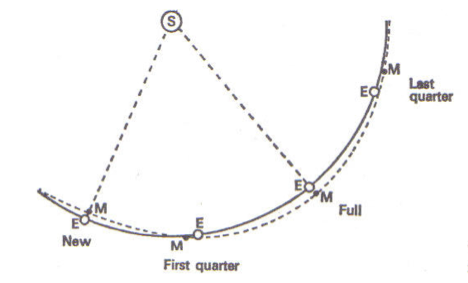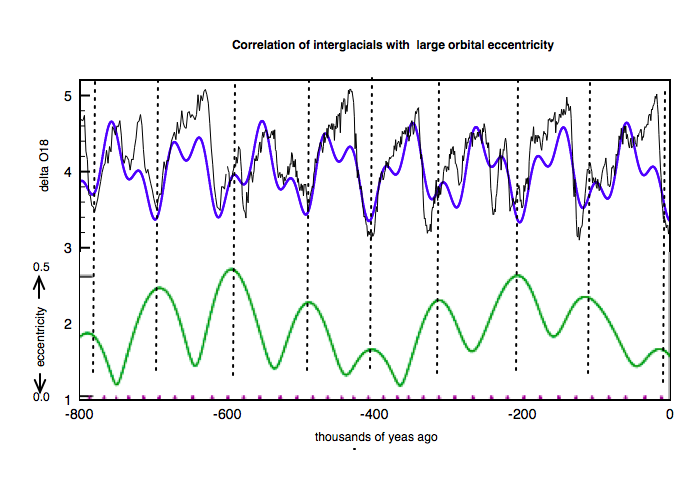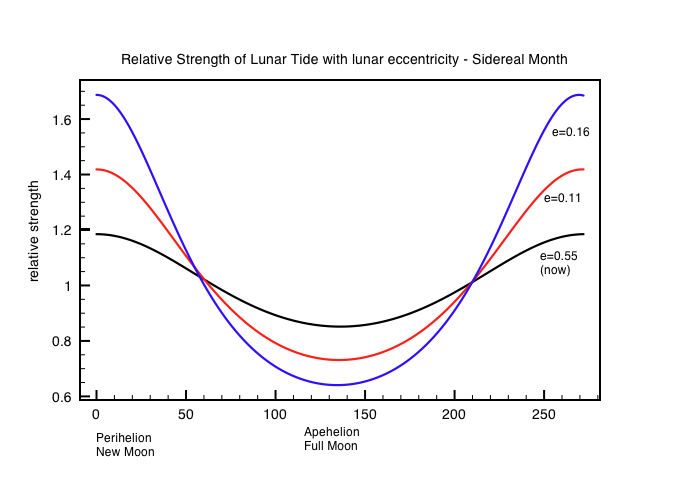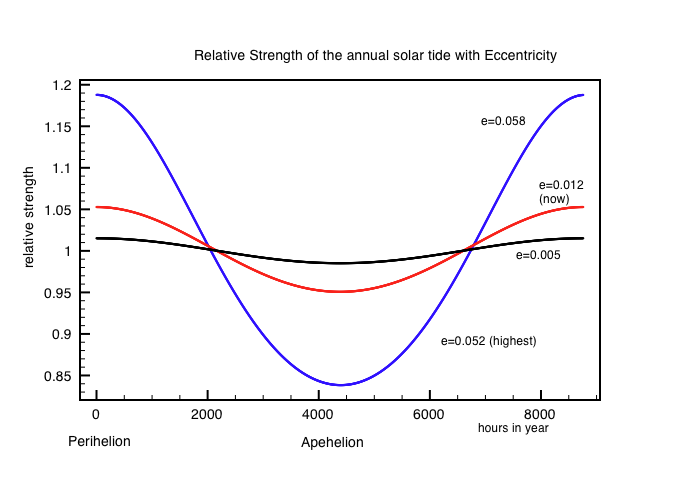- Phenomenology of Ice Ages
- What causes interglacials - part 1
- Part 2: The real cause of interglacials - Resonant dust clouds

The 100,000 and 400,000 year cycles in the ellipticity of the Earth's orbit are caused by regular gravitational effects of the other planets as they orbit the sun, particularly those of Jupiter and Saturn. Every 100,000 years the orbits of Jupiter and Saturn align themselves so that their net gravity perturbs the Earth's orbit causing it to elongate and become more elliptical. This cycle reaches a maximum every 400,000 years in regular fashion.
The moon also is effected by the same regular (Milankovitz) induced variation in its orbit around the sun. This also causes an increased elliptical orbit of the moon around the Earth. Tidal forces vary as 1/r^3 so small changes in distance can have large effects on tides.
The gravitational force of the sun on the moon is more than twice that of the Earth. For an observer in outer space the moon appears to orbit the sun just like any other planet. It's orbit is perturbed by the Earth's gravity making it slightly concave. It is only from Earth that it appears to us to be in an elliptical orbit around the Earth.
Therefore the moon like any other planet is just as effected by the gravitational effects of all the other planets . It's orbit becomes more elliptical both with respect to the sun AND respect to to Earth.
Spring tides occur when the sun and moon are aligned - new moon and full moon. When this alignment occurs at perihelion ( currently around Jan 2nd) the tides are far stronger. This is the main reason why UK storms this last week caused so much damage because they also coincided with a super-tide at perihelion and new moon. The precession of the lunar orbit plane takes 18.6 years and changes the declination angle by ± 5 deg. Once every 2000 years the projection to the ecliptic of the major axis of the lunar orbit coincides with the Earth-Sun line at the perihelion increasing tidal forces by a further 12%.

Tidal forces therefore act to break up ice sheets and change ocean heat flows. Spring tides occur when the moon and sun align together at new moon and full moon. The largest spring tides are when the Earth is at closest distance to both the sun and the moon. The Milankovitch precession term also depends strongly on the eccentricity, so when every 26,000 years perihelion coincides with the northern summer so the arctic also receives maximum insolation. In addition once a month in summer the arctic experience super tidal forces leading to the breaking up of ice and enhanced heat mixing. The combination of the two effects starts the retreat of the ice sheets and the positive feedback of lower albedo accelerates melting. Is this the real driver that forces the onset of an interglacial ?Tidal mixing within the water column and at the base of the sea ice cover can increase the heat flow from deeper water masses towards the surface causing decreased freezing and increased melting of sea ice and possibly the formation of sensible heat polynyas (Morales-Maqueda et al., 2004; Willmott et al., 2007; Lenn et al., 2010). The tidal currents can additionally increase the stress and strain on the sea ice and cause leads to open periodically within the sea ice cover (Kowalik and Proshutinsky, 1994).
How large can the tides get during 100,000y cycles of maximum eccentricity? Figures 4 and 5 show calculations of the change in tidal forces due to the sun and the moon for various values of orbital eccentricity. These calculations are based on the distance to the Earth for different times in the year for the sun, and in the sidereal month for the moon. Tides are tractional forces which depend on 1/R^3 which explains why the moon has a larger tidal pull on the oceans than does the much more massive sun. At spring tides the two tidal forces are superimposed.
The largest solar tides are up to 20% higher than those we experience today. Now lets look at the same thing for the more important lunar tide.

Summary
For 800,000 years glacial periods have ended abruptly once the orbit of the earth reaches a maximum orbital eccentricity. Milankovitch insolation theory cannot explain this 100,000 year cycle. The lunar and solar tides on earth are also affected by the same Milankovitch cycles. Their effect on ocean heat transfer and ice formation has been long documented. Maximum spring tides existing 15,000 years ago were likely at least 50% stronger than those today. This must have had the largest effect in polar regions and is directly linked to the 100,000 year eccentricity cycle. It therefore seems feasible that the moon really is responsible for the regular glacial cycle.
Note: A recent discussion on Ice Ages can be found on Euan Mearns blog. There is a also a series of posts on scienceofdoom which review how climate models struggle to explain the dynamics of ice ages. The most recent of these posts is very relevant.
References
1. The influence of the lunar nodal cycle on Arctic climate, Harald Yndestad,
2. The effect of tides on dense water formation in Arctic shelf seas, C. F. Postlethwaite, M. A. Morales Maqueda, V. le Fouest,*, G. R. Tattersall1,**, J. Holt, and A. J. Willmott, Ocean Sci., 7, 203 - 217, 2011





Reader Comments
to our Newsletter